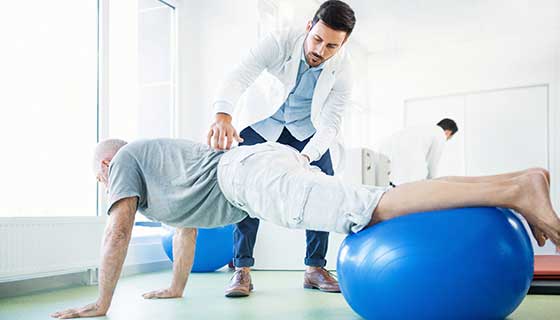Intrathecal Pain Pump
Featured Expert:
An intrathecal pump, also known as a pain pump, is a surgically implanted device that delivers medication directly to the fluid surrounding the spinal cord. Medicine delivered in this way can interrupt irregular signals traveling through the nerves and spinal column to the brain. An intrathecal pump may also be called an implanted intrathecal drug delivery system, or IDDS.
Eellan Sivanesan, M.D., director of the neuromodulation - pain medicine division and assistant professor of anesthesiology and critical care medicine, provides information on how intrathecal pumps work and what patients may expect if their doctors recommend this method of pain or spasticity control.
What You Need to Know
- An intrathecal pump may be appropriate for some people living with severe, chronic pain or spasticity that is not controlled with other methods.
- Its parts include a pump, a medication reservoir and a catheter.
- The pump is programmed to deliver small amounts of medication directly to the central nervous system. It does this by pulling medication from the reservoir and pumping it through the catheter into the spinal cord.
- Using a pump to deliver medication directly to the spinal cord and nerves is more effective than taking medicine by mouth or vein.
What is a pain pump?
A pain pump is a small device, implanted with surgery, that allows direct delivery of medicine to the spinal cord and nerves. It consists of several parts, including a pump and reservoir placed in the abdomen (belly) and a catheter placed in the intrathecal space of the spinal cord.
The intrathecal space (sometimes called the subarachnoid space) is the area between the spinal cord and the thin, strong membranes that surround and protect it. The intrathecal space holds the cerebrospinal fluid that bathes the spinal cord. Infusing medication directly into this area helps it reach the spinal cord and nerves, where it can control pain or the abnormal muscle contractions that lead to spasticity.
Because the intrathecal pump delivers medication directly to this area, powerful relief can be achieved with a much lower dose (less than 1%) than what’s found in pills or injections, which become diluted as they flow throughout the body in the digestive system or bloodstream. Using a pump may also reduce medication side effects common with long-term pill use.
In two studies looking at patients with cancer-related pain and pain from AIDS, researchers found that intrathecal pumps afforded greater pain control and more manageable side effects than traditional oral pills.
How does a pain pump work?
The parts of the intrathecal pump are placed in your body through a surgical procedure. There are several parts:
- A thin, flexible tube called a catheter is inserted in the intrathecal space surrounding the spinal cord.
- An extension catheter attaches to the catheter in the intrathecal space and goes around the torso.
- The extension catheter attaches to the pump, a round device that is about 1 inch thick and 3 inches across. The pump is implanted under the skin of the abdomen (belly). Your surgeon will program the pump to deliver a measured dose of medication directly to the intrathecal space at specific times.
- Inside the pump is a hollow, refillable reservoir that holds the medication. When the reservoir is empty, it can be refilled with a needle.
- A personal therapy manager (PTM) device helps you give yourself an extra dose if you need it. The doctor will preset the PTM with the correct dosage amount so you can use it safely on your own. The PTM typically runs on two AA batteries: Make sure you have fresh batteries in the device so it is ready to use if and when you need it.
What medications are used in an intrathecal pump?
An intrathecal pump may be used with opioid pain medications, anesthetics (numbing medications) or baclofen (a drug used to treat muscle contractions and ease spasticity). Other drugs commonly used include pain medicines like clonidine and ziconotide.
Can a pain pump be removed?
Yes: If you no longer need or want the pump, or if there is a mechanical problem, it can be taken out.
Conditions Treated by an Intrathecal Pump
A pain pump may be recommended to address:
- Back or neck pain, including from compression fractures, disk pain, spinal stenosis or spondylosis.
- Pain that lingers after prior surgical procedures
- Abdominal or pelvic pain
- Extremity pain
- Complex regional pain syndrome
- Trunk pain, including postherpetic neuralgia (chronic pain that lingers after a shingles infection)
- Cancer pain, stemming from either the cancer itself or treatments such as chemotherapy
- Peripheral nerve injury pain
- Neuropathic pain
- Spasticity (muscle stiffening) due to stroke, multiple sclerosis, cerebral palsy or brain or spinal cord injury
- More rarely, other refractory (severe) chronic pain conditions, when more conservative pain therapies have failed
Intrathecal Pump Surgery at Johns Hopkins
As part of the Blaustein Pain Treatment Center, Eellan Sivanesan, M.D., specializes in the treatment of both spasticity and cancer-related pain with intrathecal pump surgery.
Who is a candidate for an intrathecal pump?
A pump may be appropriate for a person experiencing severe, long-term pain or spasticity that has not been relieved through other approaches such as pills, physical therapy or relaxation techniques.
A pain specialist will help you decide if it is a good option by asking questions about your pain, what makes it better or worse, what you have tried in the past and the impact of the pain on your life and well-being.
In general, an intrathecal pump is most likely to be recommended for people who:
- Have tried other methods of pain control, including multiple opioid pain medications, physical therapy, relaxation techniques and others
- Require pain or spasticity medicine around the clock
- Expect to live longer than six months
- Do not have a substance use disorder, increased intracranial pressure or certain psychiatric illnesses that may complicate pain treatment
Intrathecal Pump Trial
Because individuals’ response to medication varies, the intrathecal pump may not work for everyone. To help you and your doctor decide, you may undergo a trial of medication infused into the intrathecal area to see if it provides relief. Trials are rarely performed for chronic pain, but are more common for pumps to treat spasticity. In most cases, pumps for cancer pain are placed without a trial phase.
There are different ways to perform the trial:
- One dose of medication placed is into the intrathecal space with a lumbar puncture.
- Multiple doses, using lumbar puncture with or without a catheter, are placed in the intrathecal space.
- A continuous trial, in which a catheter is placed in the intrathecal space and connected to a pump that is not implanted in the body.
The trial may also help the doctor find the best place to implant the catheter and the medication that works best to relieve your symptoms.
Pain Pump Surgery
The procedure is performed by an interventional pain specialist and takes three or four hours.
Preparing for the Pain Pump Procedure
- Once you and your pain specialist have determined a pain pump is a good option for you, your surgery will be scheduled.
- Before the procedure, you may have some tests, such as a blood test and an EKG to ensure you are healthy enough to undergo the operation.
- You will be advised not to eat or drink anything after midnight before your surgery.
- Ask your doctor if and how you should take your medications the morning of your procedure.
Pain Pump Implantation: What Happens
- You will have an IV put in your arm and receive general anesthesia to keep you asleep during the implantation surgery.
- The surgery team will shave the areas on your back and belly where the device parts will be implanted.
- The surgeon makes a small incision (cut) in the skin of the low back over the spine and exposes the bone surrounding the portion of the spinal cord where the catheter will go.
- The surgeon inserts the catheter into the intrathecal space and places stitches to hold it in place.
- The surgeon creates a tunnel around your torso and places the extension catheter under the skin. Like an extension cord, the extension catheter links the catheter in the intrathecal space to the pump, which will be placed under the skin of your abdomen.
- After forming a pocket under the skin of the abdomen, the surgeon places the disk-shaped pump into the pocket and attaches the extension catheter to it.
- The surgeon sometimes secures the pump in place by stitching it to the fascia, a layer of strong connective tissue that covers the muscles of the abdomen.
- The team closes the two incisions and bandages the areas.
Recovering from Intrathecal Pump Surgery
- After a few hours of observation in the recovery room to make sure your heart rate and blood pressure have returned to normal, you will typically be discharged home.
- Your intrathecal pump will be programmed to deliver the optimal drug regularly throughout the day and night, and then you can go home.
- You may experience swelling or pain at one or both incision sites for a few days. Your doctor will make sure you have instructions on when you can remove the bandages and shower, and how to care for the incisions as they heal.
- You will be provided an abdominal binder to wear over the pump site. This promotes appropriate healing after surgery.
- After a week or two, you will return to see the surgeon who implanted the pump. He or she will make sure your incisions are healing well.
For four to six weeks after surgery:
- Do not lift anything heavy (10 pounds or more).
- Do not twist your torso or bend at the waist to pick up anything from the floor.
- Avoid extreme temperatures such as hot tubs, ice baths or saunas.
Intrathecal Pump Side Effects and Complications
Having a pain and/or spasticity pump is generally safe. Side effects and complications are rare, but can include:
- Infection
- Cerebrospinal fluid leak
- Mechanical problems with the pump or shifting of the device after strenuous exercise that may require repositioning or replacement
Living with an Intrathecal Pump
Having a pain pump in place and working should ease your pain and help you get back to some of your regular activities. Here are answers to common questions:
How is an intrathecal pump refilled?
Every one to three months, you will return to your pain doctor to have the pump refilled with medication. Sometimes these refills can be performed at home through a skilled nursing service under the guidance of a physician. The provider will remove any remaining medicine from the pump’s reservoir with a needle and then inject new medicine into the reservoir.
What happens if my pain or spasticity get worse?
If your pain level increases, your physician may be able to adjust the dosing after evaluating that the pump is working appropriately. If your pain or spasticity keeps getting worse, call your doctor, who can reprogram the pump at his or her office. You may be prescribed medicine in pill form to have available for times when the pain and/or spasticity gets worse.
Will my intrathecal pump set off metal detectors?
Yes. You will be given a card identifying you as having an implanted device in your body. Keep this with you at all times.
How long does an intrathecal pump last?
The battery of the pump is designed to last five to seven years. When the battery begins to wear down, your doctor will get a signal when you are getting it refilled. There will be time to replace the pain pump before it stops working.
Can I have an MRI with an intrathecal pump?
If you have an MRI test done, notify the doctor ordering the test and the technologist performing the MRI that you have a pain pump implanted. While the imaging is taking place, the pain pump will stop working and may alert you with an alarm. It will start working again after the test is over; however, a device representative or physician will need to double check that the pump is working appropriately after the MRI.
When should I call my doctor?
Call your doctor if the pump is beeping or if you experience any of the following:
- Increasing pain
- Redness or swelling near the pump
- Increasing nausea, fatigue, weakness, dizziness or numbness







